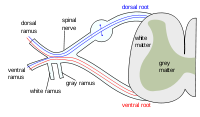
Photo from wikipedia
Neurons in the early stages of processing sensory information suffer transneuronal atrophy when deprived of their activating inputs. For over 40 y, members of our laboratory have studied the reorganization… Click to show full abstract
Neurons in the early stages of processing sensory information suffer transneuronal atrophy when deprived of their activating inputs. For over 40 y, members of our laboratory have studied the reorganization of the somatosensory cortex during and after recovering from different types of sensory loss. Here, we took advantage of the preserved histological material from these studies of the cortical effects of sensory loss to evaluate the histological consequences in the cuneate nucleus of the lower brainstem and the adjoining spinal cord. The neurons in the cuneate nucleus are activated by touch on the hand and arm, and relay this activation to the contralateral thalamus, and from the thalamus to the primary somatosensory cortex. Neurons deprived of activating inputs tend to shrink and sometimes die. We considered the effects of differences in species, type and extent of sensory loss, recovery time after injury, and age at the time of injury on the histology of the cuneate nucleus. The results indicate that all injuries that deprived part or all of the cuneate nucleus of sensory activation result in some atrophy of neurons as reflected by a decrease in nucleus size. The extent of the atrophy is greater with greater sensory loss and with longer recovery times. Based on supporting research, atrophy appears to involve a reduction in neuron size and neuropil, with little or no neuron loss. Thus, the potential exists for restoring the hand to cortex pathway with brain-machine interfaces, for bionic prosthetics, or biologically with hand replacement surgery.
Journal Title: Proceedings of the National Academy of Sciences of the United States of America
Year Published: 2023
Link to full text (if available)
Share on Social Media: Sign Up to like & get
recommendations!